The Shores of the Cosmic Ocean
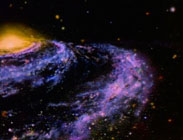 |
 |
Cosmos
by Carl Sagan
A Personal Voyage
13 episodes
|
See below for
DVD purchasing options
|
|
(Carl Sagan's Cosmos episode no. 1)
- written by Carl Sagan and Ann Druyan & Steven Soter
- series director & executive producer Adrian Malone
- Spaceship directed by Rob McCain
- other sequences directed by Richard J. Wells,
Tom Weidlinger and
Geoffrey Haines-Stiles and David F. Oyster
- edited by James Latham (film), Bea Dennis (effects),
and Roy Stewart (videotape)
- Main Title Theme by Vangelis
- Music by Vangelis, Dmitri Shostakovich, Alan Hovhaness,
Wm. Jeffery Boydstun, and others...
- 1 documentary @ 58 minutes, + special 2 min. 20th anniversary introduction
|
Data Capsule Review
|
|
by Martin Izsak
|
This is a more thoughtfully and poetically paced program than most
other astronomy documentary series, one which can still be enjoyed
today for a variety of reasons. Its soothing style is something
that most others don't even aim for, which is one plus.
The content isn't limited to the pinnacle of scientific knowledge of
the 1980's, but also digs deep into the past to trace the origins
of many astronomical advances, all of which remains relevant today.
|
Participants include:
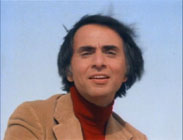 |
Dr. Carl Sagan
Astronomer, host, narrator
Voyager imaging team
Professor of Astronomy and Space Sciences,
Cornell University, Ithaca, New York
|
|
|
The production style is also of historical interest in itself,
as early usage of video chromakey with mechanically-synced cameras
showcases some great re-creations of things impossible to film,
and elaborate 2D images are stacked layer upon layer to create
convincing and extremely artful 3D motion. Unlike today where we can
brush off amazing effects with the thought that it was done by computer imagery,
these effects make you sit back and wonder just how they managed to
pull it all off in such quantities at this level of quality.
If there is one great downside to this opening episode, it is perhaps
that it doesn't quite present any kind of a plot for its pleasant and informative meanderings,
no real driving over-arching questions to which its host Carl Sagan goes digging for answers.
And this is a shame, because there is otherwise a well-structured story coming out of this episode,
one whose answers lay the groundwork for the episodes to come. All it needs is
some way for first time audiences to anticipate what is about to unfold, and to see each phase
of this magnificent journey as the next logical step forward. Those of us who know
the episode already I think are much better primed to just sit back, enjoy,
and be fascinated all over again.
Charting the First Episode:
After a very poetic opening that goes on a bit too long without any real
information, the first episode here soon settles down to two basic halves.
The first half is primarily a great zooming-in voyage from several galaxies away
to the planet Earth, along the way marveling at many astronomical phenomena
and landmarks from our perch in an imaginary spacecraft, with Carl Sagan at the helm.
This spacecraft sequence looked so expensive for late 1970's production terms,
I found myself wondering how long they could or would sustain it, and subsequently
how they could ever top it with anything else. Indeed, it goes on for a solid 22 minutes
until it rounds off the first half of the hour-long episode. But it is worth it in the
end because with it, Sagan is bringing the audience up to speed with much of the
terminology and concepts that will be used throughout the rest of the series.
We learn about the concept of the light-year as a measure of interstellar distances,
and experience the layout of the universe and our place within it
on an ever shrinking scale. We see examples of places where stars are born
(The Orion Nebula), where they are still fairly new (The Pleiades),
and contrast different ages and lifespans of various types of stars. We also
get an idea of the great dust clouds and various other types of matter
making up various galaxies including our own. And before long, we are sailing
past the familiar planets of our own solar system, getting an informative
introduction to most of them.
With this spacey opening half, Sagan is carefully taking us through WHAT we know.
The return to Earth signifies a bit of a shift, as Sagan proceeds to recount
the story of HOW we figured all that space stuff out in the first place.
This second half features many filmed sequences on our Earth, and it begins
in Egypt. Why not? We learn how a librarian in 300 B.C. managed to
accurately calculate the circumference of the Earth, based in no small
part on the idea that the Earth must be round instead of flat. A fairly simple,
but pivotal launching point for serious astronomy.
This naturally leads into the more unique of the first episode's two big set-piece
scenes - a discussion of all the wonders of books, information, and experimental discoveries
being systematically collected into the Great Library of Alexandria, reconstructed as
a highly detailed model with Carl Sagan inserted into it via some impressive then-cutting-edge
trick photography. It is impressive that we also have footage of the last remaining
piece of the Library still standing today in Egypt, thus the coverage seems quite thorough.
The topic is also quite tantalizing - that a good deal of the ideas we credit to recent Europeans
were resurrected from the remains of this hybrid Greek/Egyptian civilization of so long ago,
after spending a lot of time being forgotten. It also makes one wonder how often
knowledge and technology is lost and rediscovered. This Great Library of Alexandria
is the earliest known systematic gathering of the world's knowledge that we can
easily verify today, but were there others before then, others that we have completely
forgotten? Has evidence of other lost civilizations simply not yet surfaced to
widespread public awareness?
At this point, we accelerate through the story of ever growing, ever expanding
astronomical knowledge, and we get some teasers for the things we will learn
in future episodes, and see some of the places and historical figures that we will learn
about in much more detail in episodes 3, 6, and 10. The goal here though is to
get an overview of the big picture of astronomical discovery, to move past the
question of what we know and how we know it, and finally move on to our best current idea
of exactly WHEN we think we are in the big cosmic picture.
Our final set-piece sequence is the introduction of the "Cosmic Calendar",
which compresses the history of the universe so far into 1 "year".
It's a fairly decent and useful way of making a point of contrast between
the lengthy existence of the universe
and the fairly recent introduction of our Earthly intelligent and sentient form,
able to contemplate our own existence in this grand scheme of things.
And with that, the first episode of Cosmos bows out, leaving much for its audience to ponder,
and many more grand ideas to be explored in further episodes....
I would say that this episode seems to have a higher percentage of
"money shots" than many episodes that follow, and this premiere episode
seems to be a bit more polished in production terms. As for content,
Sagan is very much on top of his material here, and I feel he didn't
yet really step very deeply into many trouble areas.
The end result is that, even though he is still warming up
for later topics here, this remains one of the best and most engaging
episodes of the "Cosmos" series.
|
International Titles - for the series:
Deutsch (German): "Unser Kosmos: Eine Reise durch das Weltall, mit Carl Sagan"
Español (Spanish): "Cosmos: un viaje personal"
Magyar (Hungarian): "Kozmosz: Személyes utazás"
Русский (Russian): "Космос, с Карлом Саганом: персональное путешествие"
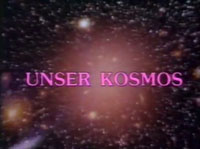
Unser Kosmos
(Our Cosmos) |
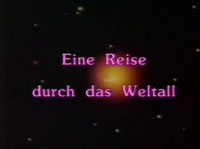
Eine Reise durch das Weltall
(A Voyage through Space) |
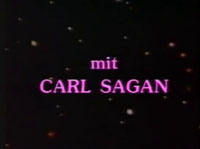
mit Carl Sagan
(with Carl Sagan) |
The original series with Carl Sagan was subtitled "Eine Reise durch das Weltall" in German,
which roughly translates to "A voyage through space". Note that the new 2014 series
with Neil deGrasse Tyson is labeled "Die Reise geht weiter" in German,
meaning "The voyage continues..."
Most other languages were a bit more literal.
The Russian version translates to: "Cosmos, with Carl Sagan: Personal Travel".
Note that Sagan's name is not only spelled in Cyrillic, but comes with extra suffixes
in order to agree with the preceding preposition.
International Titles - for this first episode:
Deutsch: "Die Küsten des kosmischen Ozeans"
Español: "En la orilla del océano cósmico"
Magyar: "A Kozmikus óceán partjain"
Русский: Эпизод 1 - На берегах космического океана
Français (French): "Au bord de l'océan cosmique"
Italiano (Italian): "Le spiagge dell'oceano cosmico"
|

|
The German Dub
The German version "Unser Kosmos" dates back to the 1980's,
when a version dubbed into the German language was produced and shown on television.
These episodes were cut-down versions between 42 and 44 minutes long.
They featured the original 1980 soundtrack, and Sagan's voice
was completely removed whether he was featured talking on screen or not.
New narrator Norbert Langer does a good job of matching
Sagan's emotional tone and rhythms, and very often there
are enough similarities between English and German that
he even manages to achieve a half-decent lip-synch.
It's by far the most convincing foreign dub of Cosmos
I've seen yet.
Edited for Time
With the German episodes cut down to approximately 2/3 of their original length,
it begs the question of what remained versus what hit the cutting room floor.
Episode 1 was subtly nipped and tucked throughout, maintaining its basic
structure and hitting all four of its major points - a lengthy space tour,
the deduction of the circumference of the Earth, the Great Library,
and the Cosmic Calendar. Bits that went missing included various portions
of the tour such as the exploration of the Orion Nebula and the Pleiades,
the lush parts of the return to Earth (the Germans went straight from space
to the tower in the Egyptian desert), a brief bit in the boat before exploring
Alexandria. Surprisingly, the repeated footage that teases future episodes is
still here - I'd have thought they could have excised it and waited
until episodes 3, 6, and 10 to see it properly.
|
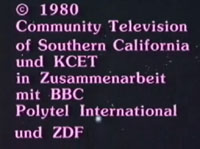
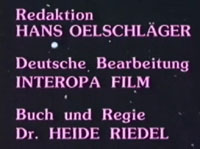
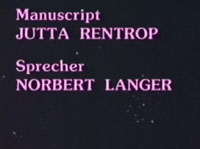
|
The Spanish were perhaps luckier in getting the series dubbed into their
language with the episodes at full length, and early enough to also feature
the original 1980 music sequences.
Versions dubbed into Hungarian and Russian used the later 2000 Collectors' Edition
music sequence. A curious feature of the Hungarian version was its use of two
different dubbing voices. When Sagan was featured on screen, his own voice could still
be heard faintly in English, while a friendly Hungarian chap was dubbed on top.
When Sagan was not on screen, his own English voice was completely removed,
and a different man with a deep voice spoke with great gravitas about the universe
at large. The contrast between the two Hungarian voices produced a nice effect.
One major Russian dub provides quite a different experience again, as all of Sagan's narration
is spoken by a woman, on top of Sagan's faint English voice which is always also present.
Curiously, bits spoken by historical characters are also dubbed into Russian,
and in this case male voices are used.
(This set-up becomes particularly funny in episode six when Sagan debates photo findings
with Larry Soderblom and Lonnie Lane - Soderblom and Lane are translated by male voices,
while Sagan's bits are voiced by the female narrator in character, who also puts on
a higher pitched tone while voicing Linda Morabito's bits.)
The Music - Episode 1
In 1980, the original Cosmos had a somewhat different musical background
to what is now found in the 2000 Collectors' Edition on DVD and Blu-ray.
Though Episode One features fewer differences than other episodes,
we decided to roll out new music charts for all 13 episodes of Cosmos that
list both soundtracks simultaneously, so that readers can see what changed
and what stayed the same.
Compositions that were unique to the original
1980 version are typically shaded blue-grey. Compositions that
remained the same for both versions are stretched out across both
sets of columns, although one rarely finds an exact sync between
the two versions. In some cases such as Shostakovich's 11th Symphony,
different recordings with different timings are used in each version.
And as before, anything written in green text
represents a name I made up to help keep some music better identified in my own head.
| Collectors' Edition 2000 (DVD) |
Original 1980 | |
| Composer/Performer | Title 2000 |
Composer/Performer | Title 1980 | Notes |
| Vangelis |
Symphony to the Powers B, Movement Three
also known as "Theme from Cosmos"
from the
"Heaven and Hell" Album, Side A |
Title Music |
| Vangelis | Theme from Cosmos | Cosmic Tour #1: Launch |
| Vangelis | Creation Du Monde (nearly the entire 10 min. track) |
Cosmic Tour #2
|
| Dmitri Shostakovich | Symphony No. 11 "The Year 1905" Movement 1 - "The Palace Square", part A
This cue defines part A. - Wait, what's part A?
(2000 version =
Fanfare excerpt, then all of Part A) | | | |
(1980 version = Part A leading into Part B) |
|
Cosmic Tour #3 |
| Béla Bartók? | Music for Strings, Percussion,
and Celesta, Mv. 1? | intro Mars |
| Vangelis | Theme from Cosmos | Cosmic Tour #4 |
| Ludwig von Beethoven | Symphony No. 7, Movement 1 (excerpt) | Return to Earth |
| Vangelis | Entends Chiens #2 - Ancient Angles
What's this? | Le Orme | Notturno (excerpts) | |
| Richard Harvey | Migration | Le Orme | Notturno (again) | |
| Nikolai Rimsky-Korsakov | The Tale of Tsar Saltan - Movement 2
"The Tsarina in a Barrel at Sea" | |
| Vangelis | Entends Chiens #2 - Ancient Angles | (production sound) | |
| ?? unknown | ??? - Egyptian marketplace background | |
| Alan Hovhaness | Symphony No. 4
- 3 excerpts from Movement 1
- excerpt from Movement 3
- excerpt from Movement 1
- excerpt from Movement 3
| music for the
Great Library |
| Alan Hovhaness | Spirit of Ink -
"Angelic Salutation" - 2 excerpts | flute trio |
| Alan Hovhaness | Symphony No. 19 - "Trekking Theme" excerpt | |
| Dmitri Shostakovich | Symphony No. 5 Movement 3
"Lost Cause" excerpt | Lament for Kepler |
| Nikolai Rimsky-Korsakov | Russian Easter Festival Overture | |
| Harry Gold | Joy Ride |
Fud Livingston
(composer, arranger,
solo Clarinet,
solo Tenor Sax) | "Imagination"
Red Nichols
(Cornet / Band Leader)
Miff Mole (Trombone)
|
1920's Clarinet
and Dixieland Band |
| Wm. Jeffery Boydstun |
|
Heldon | Perspective I | Theme for the
Cosmic Calendar |
| Vangelis | Theme from Cosmos | Closing Theme,
End Credits |
| Vangelis | Comet 16 |
n/a | Collector's Edition 2000
Credits |
The most baffling part of any list of the music for the first episode of Cosmos
has got to be the inclusion of Bartok's Miraculous Mandarin.
Has anyone actually heard it in the program? Is anyone really confident about when it
actually featured?
It's telling that the cue sheet indicates that only "a few seconds" were used.
There appears to be something unidentifiable playing for a few seconds when Mars is introduced,
only on the original 1980 music sequence, which sounds to me like it could be Bartok.
In fact, I suspect it is more likely to be from the flip side of the vinyl LP coded
"London CS6783" - so not "Miraculous Mandarin", but "Music for Strings, Percussion, and Celesta".
It's hard to hear enough of it on the program to make an exact identification though,
as it is buried beneath dialogue and a loud whiney sound effect.
I have to wonder though, why would they even bother to use such a small snippet
where it could barely be heard or appreciated? It's easily the least important
piece of all the music ever listed for the episode.
I'm not surprised later versions dropped it,
along with its copyright clearing challenges.
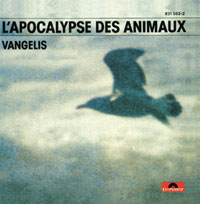
Vangelis
L'Apocalypse des Animaux (1973)
Original music
composed by
Vangelis
for the 1972 TV documentary
Audio CD
|
Vangelis - L'Apocalypse Des Animaux
All Tracks by Vangelis
This album available on CD or MP3 download.
Track Listing:
1. Apocalypse Des Animaux - Generique (1:28)
2. La Petite Fille De La Mer (6:01)
3. Le Singe Bleu (7:42)
4. La Mort Du Loup (3:07)
5. L'Ours Musicien (1:05)
6. Creation Du Monde (10:08)
7. La Mer Recommencee (5:56)
Total Time: 35:27
|
We're here for the very excellent track
"Creation du Monde", which is part of the
opening tour of the universe in the first
episode of "Cosmos", and was used many times
in other episodes as well, although I don't
think you'll find quite the entire ten minute track
appearing in its entirety in the show.
At any rate, this whole CD album
is full of beautiful Vangelis pieces.
|
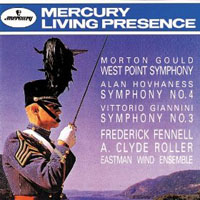
Alan Hovhaness
Symphony No. 4
Original music
composed by
Alan Hovhaness
Three Symphony mp3 album
These recordings by the Eastman Wind Ensemble
are the very ones used in "Cosmos".
|
All Tracks performed by Eastman Wind Ensemble
This album available on mp3 download.
Track Listing:
Morton Gould: West Point Symphony:
1. Movement 1 - Epitaphs (12:01)
2. Movement 2 - Marches (8:14)
Vittorio Giannini: Symphony No. 3:
3. Movement 1 - Allegro energico (7:11)
4. Movement 2 - Adagio (7:30)
5. Movement 3 - Allegretto (3:17)
6. Movement 4 - Allegro con brio (4:55)
Alan Hovhaness: Symphony No. 4:
7. Movement 1 - Andante (8:46)
8. Movement 2 - Allegro (4:23)
9. Movement 3 - Andante espressivo (7:47)
|
|
This documentary has become available on DVD.
Cosmos - by Carl Sagan: A Personal Voyage
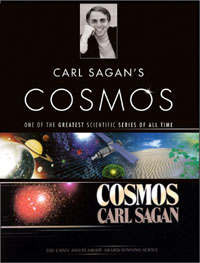
13 hour-long episodes, 1980
|
U.S.


| Canada


| U.K.


|
Comments on this article are welcome. You may contact
the author from this page:
Contact page
|


















